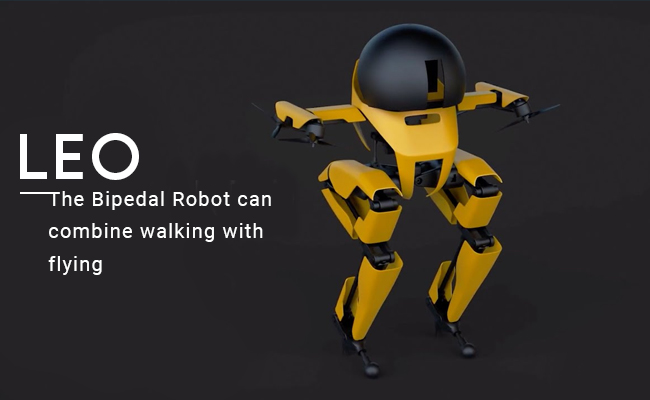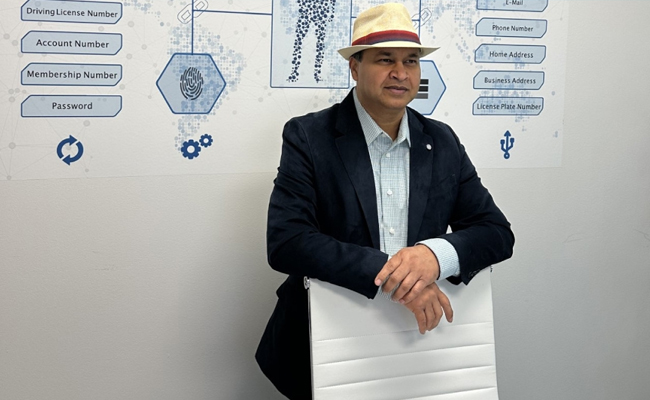‘LEO’- the Bipedal Robot can combine walking with flying
By MYBRANDBOOK

Researchers at Caltech have built a bipedal robot that combines walking with flying to create a new type of locomotion, making it exceptionally nimble and capable of complex movements.
Part walking robot, part flying drone, the newly developed LEONARDO (short for LEgs ONboARD drOne, or LEO for short) can walk a slackline, hop, and even ride a skateboard. Developed by a team at Caltech's Center for Autonomous Systems and Technologies (CAST), LEO is the first robot that uses multi-joint legs and propeller-based thrusters to achieve a fine degree of control over its balance.
A paper about the LEO robot was published online on October 6 and was featured on the October 2021 cover of Science Robotics.
Bipedal robots are able to tackle complex real-world terrains by using the same sort of movements that humans use, like jumping or running or even climbing stairs, but they are stymied by rough terrain. Flying robots easily navigate tough terrain by simply avoiding the ground, but they face their own set of limitations: high energy consumption during flight and limited payload capacity.
By using a hybrid movement that is somewhere between walking and flying, the researchers get the best of both worlds in terms of locomotion. LEO's lightweight legs take stress off of its thrusters by supporting the bulk of the weight, but because the thrusters are controlled synchronously with leg joints, LEO has uncanny balance.
LEO stands 2.5 feet tall and is equipped with two legs that have three actuated joints, along with four propeller thrusters mounted at an angle at the robot's shoulders. When a person walks, they adjust the position and orientation of their legs to cause their center of mass to move forward while the body's balance is maintained. LEO walks in this way as well: the propellers ensure that the robot is upright as it walks, and the leg actuators change the position of the legs to move the robot's center of mass forward through the use of a synchronized walking and flying controller. In flight, the robot uses its propellers alone and flies like a drone.
The LEO project was started in the summer of 2019 with the authors of the Science Robotics paper and three Caltech undergraduates who participated in the project through the Institute's Summer Undergraduate Research Fellowship (SURF) program.
Next, the team plans to improve the performance of LEO by creating a more rigid leg design that is capable of supporting more of the robot's weight and increasing the thrust force of the propellers. In addition, they hope to make LEO more autonomous so that the robot can understand how much of its weight is supported by legs and how much needs to be supported by propellers when walking on uneven terrain.
The researchers also plan to equip LEO with a newly developed drone landing control algorithm that utilizes deep neural networks. With a better understanding of the environment, LEO could make its own decisions about the best combination of walking, flying, or hybrid motion that it should use to move from one place to another based on what is safest and what uses the least amount of energy.


InterGlobe’s Rahul Bhatia and C.P. Gurnani together announce
In a move that is set to transform the AI landscape, Rahul Bhatia, Group M...

Download masked Aadhaar to improve privacy
Download a masked Aadhaar from UIDAI to improve privacy. Select masking w...

Sterlite Technologies' Rs 145 crore claim against BSNL rejecte
An arbitrator has rejected broadband technology company Sterlite Technolog...

ID-REDACT® ensures full compliance with the DPDP Act for Indi
Data Safeguard India Pvt Ltd, a wholly-owned subsidiary of Data Safeguard ...


Technology Icons Of India 2023: Ajit Balakrishnan
The Company markets specific channels, community features, local langu...

Technology Icons Of India 2023: Byju Raveendran
Byju Raveendran is the founder of edutech start-up Byju’s. Raveendra...

Technology Icons Of India 2023: Debjani Ghosh
Debjani Ghosh is the first woman president of NASSCOM (the umbrella bo...


TCIL continues to strengthen India with its technology expertise
TCIL undertakes consultancy & turnkey projects in the field of Telecom...

INDIANOIL helps reach precious petroleum fuels to every nook and corner of the country
IndianOil, a diversified, integrated energy major with presence in alm...

ITI Limited widening its focus area
ITI Limited is a public sector undertaking company, has manufacturing ...


WPG C&C COMPUTERS & PERIPHERALS PVT. LTD.
WPG C&C Computers & Peripherals (India) was incorporated in 2008 and ...

INTEGRA MICRO SYSTEMS PVT. LTD.
Integra is a leading provider of innovative hi-technology products an...

SAVEX TECHNOLOGIES PVT. LTD.
Savex Technologies is the 3rd largest Information & Communication Tec...